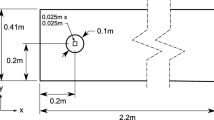Abstract
A data-driven two-branch deep neural network (DNN), to be referred to as \(\lambda \)-DNN, used to predict scalar fields is presented. The network architecture consists of two separate branches (input layers) connected to the main one towards its output. In multi-disciplinary shape optimization problems, such as those this paper is dealing with, the input to the \(\lambda \)-DNN contains data relevant to the geometrical shape and the case itself. Herein, the \(\lambda \)-DNN is used in conjugate heat transfer (CHT) analysis and shape optimization problems, synergistically with codes simulating flows over the fluid domain and solving the heat conduction equations over the solid one. It is used to optimize a duct and an internally cooled turbine blade-airfoil surrounded by hot gas. The \(\lambda \)-DNNs, after being trained on fields computed using the CHT solver, are used as surrogates for either the heat conduction equation solver of the solid domain, replicating either one out of the two disciplines of the problem or the coupled CHT solver.














Similar content being viewed by others
Abbreviations
- CFD:
-
Computational fluid dynamics
- CHT:
-
Conjugate heat transfer
- CNN:
-
Convolutional neural network
- DNN:
-
Deep neural network
- EA:
-
Evolutionary algorithm
- FSI:
-
Fluid solid interface
- MAEA:
-
Metamodel-assisted evolutionary algorithm
- MLP:
-
Multilayer perceptron
- NURBS:
-
Non-uniform rational B-splines
- PDE:
-
Partial differential equation
- PSM:
-
Problem specific model
- RANS:
-
Reynolds-averaged Navier Stokes
- RBF:
-
Radial basis function
References
Advances in Evolutionary and Deterministic Methods for Design (2019) Optimization and control in engineering and sciences, vol 36. Springer. 978-3-319-11540-5
Abadi M, Agarwal A et al (2015) Tensorflow: large-scale machine learning on heterogeneous systems . http://tensorflow.org/. Software available from tensorflow.org
Agarap AF (2018) Deep learning using rectified linear units (ReLU). CoRR arXiv:abs/1803.08375
Asouti V, Trompoukis X, Kampolis I, Giannakoglou K (2011) Unsteady CFD computations using vertex-centered finite volumes for unstructured grids on graphics processing units. Int J Numer Methods Fluids 67(2):232–246
Bishop CM (2007) Pattern recognition and machine learning (information science and statistics). Springer, Berlin
Büche D, Schraudolph N, Koumoutsakos P (2005) Accelerating evolutionary algorithms with Gaussian process fitness function models. IEEE Trans Syst Man Cybern C 35(2):183–194
Duchi J, Hazan E, Singer Y (2011) Adaptive subgradient methods for online learning and stochastic optimization. J Mach Learn Res 12:2121–2159
Giannakoglou K (2002) Design of optimal aerodynamic shapes using stochastic optimization methods and computational intelligence. Prog Aerosp Sci 38(1):43–76
Glorot X, Bordes A, Bengio Y (2011) Deep sparse rectifier neural networks. In: Proceedings of the 14th international conference on artificial intelligence and statistics, vol 15, pp 315–323
Goodfellow I, Bengio Y, Courville A (2016) Deep learning. MIT Press, Cambridge
Han R, Wang Y, Zhang Y, Chen G (2019) A novel spatial-temporal prediction method for unsteady wake flows based on hybrid deep neural network. Phys Fluids 31(12):127101
Hastie T, Tibshirani R, Friedman J (2016) The elements of statistical learning, second edition: data mining, inference, and prediction. Springer, Berlin
Iuliano E, Quagliarella D (2013) Proper orthogonal decomposition, surrogate modelling and evolutionary optimization in aerodynamic design. Comput Fluids 84:327–350
Jin X, Cheng P, Chen WL, Li H (2018) Prediction model of velocity field around circular cylinder over various Reynolds numbers by fusion convolutional neural networks based on pressure on the cylinder. Phys Fluids 30(4):305–320
Kapsoulis D, Tsiakas K, Trompoukis X, Asouti V, Giannakoglou K (2018) Evolutionary multi-objective optimization assisted by metamodels, kernel PCA and multi-criteria decision making techniques with applications in aerodynamics. Appl Soft Comput 64:1–13
Karakasis M, Giannakoglou K (2006) On the use of metamodel-assisted, multi-objective evolutionary algorithms. Eng Optim 38(8):941–957
Kingma DP, Ba J (2015) Adam: a method for stochastic optimization. In: Bengio Y, LeCun Y (eds) 3rd international conference on learning representations, ICLR 2015, San Diego, CA, USA, May 7–9, 2015, conference track proceedings
Kontou M, Kapsoulis D, Baklagis I, Giannakoglou KC (2020) \(\lambda \)-DNNs and their implementation in aerodynamic and conjugate heat transfer optimization. In: EANN, proceedings of the international neural networks society, vol 2, pp 202–214. Springer
Li Y, Chang J, Kong C, Wang Z (2020) Flow field reconstruction and prediction of the supersonic cascade channel based on a symmetry neural network under complex and variable conditions. AIP Adv 10(6):065116
Liu Y, Dinh N, Sato Y, Niceno B (2018) Data-driven modeling for boiling heat transfer: using deep neural networks and high-fidelity simulation results. Appl Therm Eng 144:305–320
Mabrouk MS, Abdelhalim MB, Elewa ES (2018) A developed system based on nature-inspired algorithms for DNA motif finding process. Neural Comput Appl 30(7):2059–2069
Martin MJ, Andres E, Lozano C, Valero E (2014) Volumetric b-splines shape parametrization for aerodynamic shape design. Aerosp Sci Technol 37:26–36
Martins JRRA, Ning A (2020) Engineering design optimization. Cambridge University Press, Cambridge
Menter F, Kuntz M, Langtry R (2003) Ten years of industrial experience with SST turbulence model. Heat Mass Transf 4:625–632
Moretti R, Errera M, Couaillier V, Feyel F (2017) Stability convergence and optimization of interface treatments in weak and strong thermal fluid-structure interaction. Int J Therm Sci 126:23–37
Ong YS, Lum KY, Nair PB, Shi DM, Zhang ZK (2003) Global convergence of unconstrained and bound constrained surrogate-assisted evolutionary search in aerodynamic shape design. In: CEC 2003, vol 3. Canberra, Australia, pp 1856–1863
Romero G, Arenas MG, Castillo PA, Merelo JJ, Mora AM (2011) Online vs. offline ANOVA use on evolutionary algorithms. In: Advances in computational intelligence, pp 341–347. Springer, Berlin, Heidelberg
Rumelhart DE, Hinton GE, Williams RJ (1986) Learning representations by back-propagating errors. Nature 323(6088):533–536
Sekar V, Jiang Q, Shu C, Khoo BC (2019) Fast flow field prediction over airfoils using deep learning approach. Phys Fluids 31(5):057103
Spalart P, Allmaras S (1994) A one-equation turbulence model for aerodynamic flows. Rech Aerosp 1:5–21
The EASY (Evolutionary Algorithms System) Software (2008) http://velos0.ltt.mech.ntua.gr/EASY
Tieleman T, Hinton G (2012) Lecture 6.5—RmsProp: divide the gradient by a running average of its recent magnitude. COURSERA: Neural Networks for Machine Learning
Xie Y, Peng M (2019) Forest fire forecasting using ensemble learning approaches. Neural Comput Appl 31:4541–4550
Zhang H, Shao J, Salakhutdinov R (2019) Deep neural networks with multi-branch architectures are intrinsically less non-convex. Proc Mach Learn Res 89:1099–1109
Acknowledgements
The authors are thankful to the Greek Research and Technology Network (GRNET) High Performance Computing Services for providing the computational means to conduct this research, through the CGT-DNN Project.
Author information
Authors and Affiliations
Corresponding author
Ethics declarations
Conflict of interest
The authors declare that they have no conflict of interest.
Additional information
Publisher's Note
Springer Nature remains neutral with regard to jurisdictional claims in published maps and institutional affiliations.
Rights and permissions
About this article
Cite this article
Kontou, M., Kapsoulis, D., Baklagis, I. et al. \(\lambda \)-DNNs and their implementation in conjugate heat transfer shape optimization. Neural Comput & Applic 34, 843–854 (2022). https://doi.org/10.1007/s00521-021-05858-2
Received:
Accepted:
Published:
Issue Date:
DOI: https://doi.org/10.1007/s00521-021-05858-2




